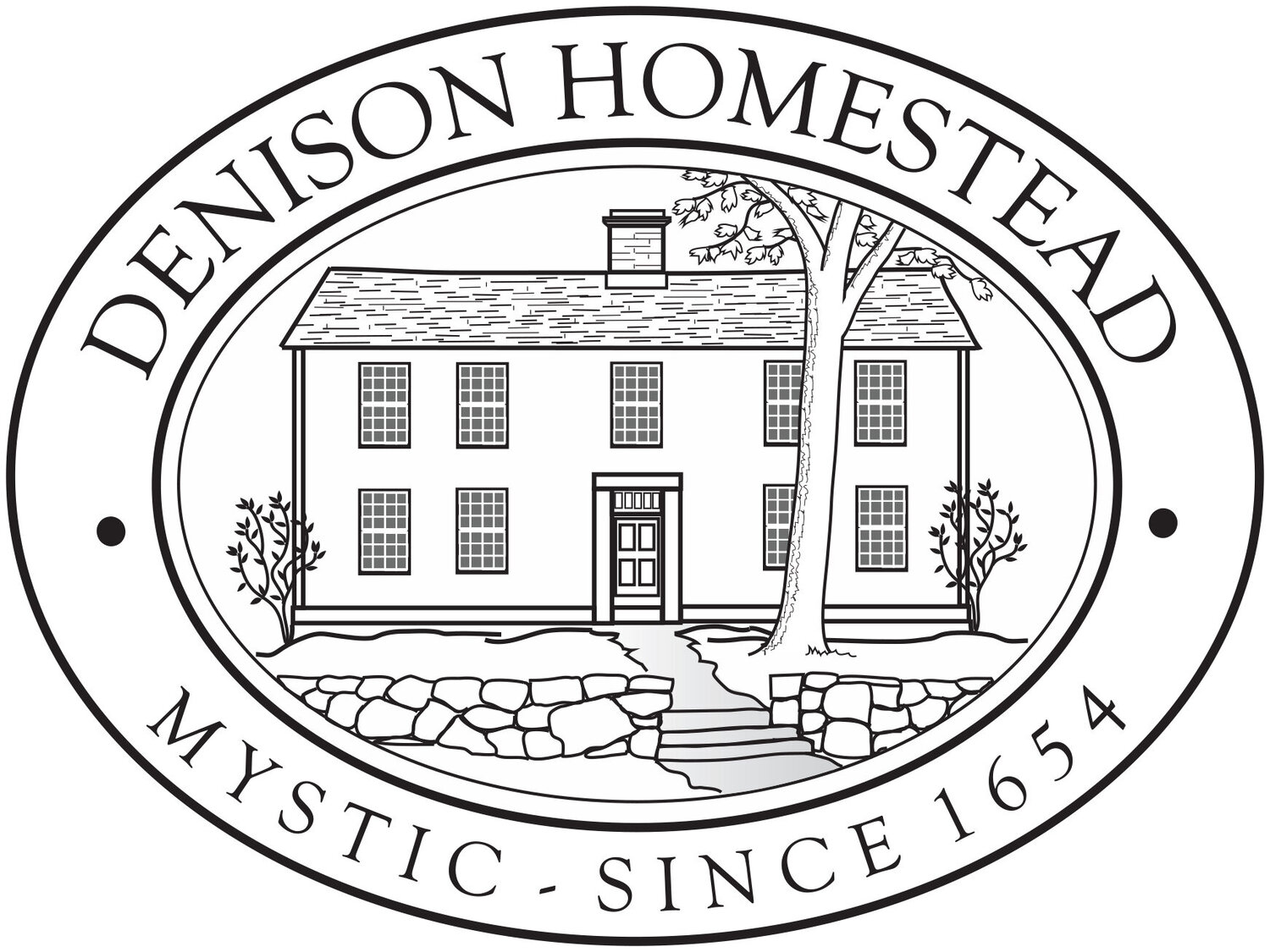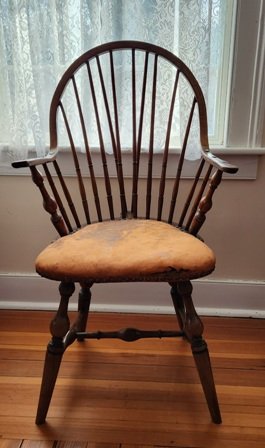Annie Gates’ Walking Stick
This ebony walking stick with an ivory top that was used by Annie Gates, the last owner of the Denison Homestead.
Amos Denison Allen, Furniture Maker
Amos Denison Allen (1774 - 1855) of Windham, Connecticut was the third-great-grandson of Captain George Denison and Ann Borordell. He was the second son of Amos Allen Jr. (1744 - 1788) and Anna Babcock (1745 - 1775); he was one of 11 children. Amos' found work as a chairmaker's apprentice to Colonel Ebenezer Tracy of Lisbon, Connecticut; who’s specialty was Windsor and Sheraton chairs.
Buttonhole ripper
Steel chisel with ivory handle, owned by Thankful Denison Clift, donated by Thankful Cornwall.
Cloak Clasp
Metal hook and eye clasp, owned by Thankful Denison Clift, donated by Thankful Cornwall.
Thankful Denison Clift (1780 - 1861)
Artist: Orlando Hand Bears (1837)
Medium: Oil on canvas, 33 1/3 x 27 1/2 inches
Provenance: Donated by Thankful Cornwall (1908 - 2001) in 1963
Thankful Denison Clift was the daughter of Isaac Denison and Eunice Williams (she was third great-granddaughter to Captain George Denison and Ann Borodell). She was born on the 20th of May 1780. After her marriage to Colonel Amos Clift, she moved to the Groton side of Mystic, to 26 Clift Street where she had eight children, five boys and three girls; four of her sons and one daughter lived to adulthood. Her husband died in 1818, shortly after the birth of their last child. Thankful took over his real estate business, and was perhaps the first woman developer in the region. Their son, Amos Clift, continued the family business and built the Portersville Academy and the Congregational Church at Holmes and Willow Streets on the Stonington side of Mystic. Mrs. Thankful Denison Clift died on the 22nd of January, 1861 at the age of 81 and is buried beside her husband and family in Elm Grove Cemetery in Mystic.
Thankful Denison Clift's Cookbook
Sugar Caster c. 1820-1830
This pink splash lusterware sugar caster (4.25 in high x 2 in diameter) was probably made around 1820-1830 in one of the several potteries around Sunderland, England which produced inexpensive, popular lusterware in this characteristic cheerful pink. The “splash” effect was created by dripping oil onto the finish before firing. A sugar caster, sometimes also called a muf-fineer, held sugar to be sprinkled on food, like a salt shaker.
Gingerbread Clock
In 2022 the Homestead was fortunate to be given this beautiful ginger-bread clock by Denison descendant John Culver. The clock belonged to Mr. Culver's grandfather, Nate Walter Denison of Linesville, Pennsylvania. It was made by the Waterbury Clock Company, a well-known Connecticut manufacturer, operating from 1857-1944. Starting in the early 19th century Connecticut became a center for light industries including clock making. Connecticut clocks were sold by catalog around the country.
Third Hand
This item is known as a "Third Hand," it clamps to a table while the beak holds the fabric to be sewn. The depression on the bird's back would have held a small pincushion and the top of the clamp would have held a larger cushion which would have been used to secure fabric.
Terry Clock
This mantel clock was made c. 1830s by Eli Terry & Sons. It has its original eglomise (painted glass) panel, which shows a white house.
Eli Terry (1772-1852) was an important person in Connecticut manufacturing. He earned the United States' first patent for a clock mechanism in 1797, and pioneered the use of interchangeable parts to become one of the very first mass-manufacturers. Together with his competitors-who were often imitators, to the point of patent infringement, Terry transformed the clock from a rare luxury to a household necessity.
In 1840, English traveler G.W. Featherstonebaugh noted the ubiquity of Connecticut-made clocks: "In Kentucky, Indiana, Illinois, Missouri, and here in every dell of Arkansas and in every cabin where there was not a chair to sit on, there was sure to be a Connecticut clock."
Our clock is Terry's classic pillar and scroll design, which was first sold in 1823 for $14.
Bed Warmer
A house like the Homestead could be terribly cold during 18th century winters; numerous accounts speak of water freezing in bedroom pitchers. A bedwarmer, or warming pan, could help. In her memoirs, Caroline King described how it was used during her visit at a family friend’s house in Newburyport, MA in January 1834: “After I had hastily made my preparations for bed, Aunt Nanny brought in a shining brass warming pan, filled with glowing coals, which she moved swiftly up and down between the polished icy cold sheets of the bed, leaving behind, beside the grateful warmth, a smell of just-going-to-be-scorched linen, which is inseparable from my memory of that old time luxury.”
Mary Washington Medal
Soon after the death of George Washington's mother Mary Ball Washington in 1790, Congress proposed to erect a memorial. A century later, it had still not been completed. In 1833, Denison descendant and shipping magnate Silas E. Burrows (1794 - 1870) had given $10,000 for the monument and Andrew Jackson had delivered a dedication, but progress stalled. In 1889 a local developer tried to sell the land the unfinished memorial was on. It sparked outraged women around the country to form two competing organizations, the Frederick Mary Washington Memorial Association and National Mary Washington Memorial Association. Thanks to their fundraising and organization, a sixty-foot granite obelisk was finally completed in 1894. The National Mary Washington Memorial Association presented this medal to their member Mary Jane Greene (1826 - 1901), who happened to be Silas Burrow's daughter. The Mary Washington Memorial is said to be the first historical monument created to honor a woman by women.
Revolutionary War Cloak
Blue wool cloak, c. 1770s, with later lining of tartan and glazed cotton and probable replacement collar. According to family tradition, Isaac Denison (1751-1817), wore this cloak during his service in the Revolutionary War. Isaac was the son of Captain Daniel Denison and Esther Wheeler. He grew up in Mystic, enlisted in 1777, and served in Captain Abraham Child’s company. Isaac’s son, 18 year old Frederic Denison, was the only American casualty of the Battle of Stonington in the War of 1812.
Teething Ring c. early 1900s
Ivory teething ring on a light blue ribbon, probably dating from the early 20th century. Before the availability of modern materials like silicon, teethers were often made from bone or coral.
Marble Game Set
This game-set was given to Annie Borodell Denison Gates (1866 - 1941) by her father, Captain Edgar Denison (1833 - 1896).
Mourning Ring
This is a mourning ring made in memory of Zina Denison, who died in 1790 at the age 39. At a time when many people lost loved ones young, mourning jewelry was a common method of memorializing the dead. Zina was a great-great-grandson of Captain George Denison and Ann Borodell.
Bandbox
Between 1825 and 1850, pasteboard or light wood "bandboxes" were an easy, common way to store or transport goods, like shopping bags today. They were often made of wallpaper, but sometimes paper manufacturers printed paper especially for them. This blue paisley bandbox includes a blank box for the owner to write her name; the newspaper used for the lining refers to New London and Uncasville, meaning this box was probably made locally.
Coal Stove c. 1840 - 1843
Currently in storage in the Homestead’s Barn. This style of coal stove was designed and manufactured by James Wager in Troy, NY.
Are These Your Ancestors?
These three portraits have been stored in the back of the collections room at the Denison Homestead for many years. Although they are among the most impressive and also the largest paintings the Homestead has, we have no records on them at all. Since they do not appear in early photographs or inventories of the house, we think they must have been given to the Homestead by a Denison descendant, possibly sometime in the 1990s. So we thought we’d ask our membership - are these your ancestors?





















